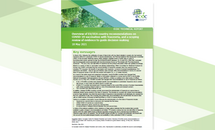Overview of EU/EEA country recommendations on COVID-19 vaccination with Vaxzevria, and a scoping review of evidence to guide decision-making
This technical report provides a summary of the evidence available at the time of the publication and what will be required in the future to support EU/EEA countries taking decisions on administration of the second dose, following a first dose of Vaxzevria. Since new evidence is being generated continuously and safety monitored on an ongoing basis, it is essential for readers to consider the latest available information.
Executive Summary
Key messages
In March 2021, following the notification of cases of blood clots with low blood platelets in people who had received Vaxzevria (AZD1222) (previously COVID-19 Vaccine AstraZeneca), the Pharmacovigilance Risk Assessment Committee (PRAC) of the European Medicines Agency (EMA) initiated a detailed review of safety data on cases of thromboembolic events received through the EUDRAVIGILANCE database. On 16 April 2021, EMA PRAC concluded that thromboembolic events associated with thrombocytopenia (known as ‘Thrombosis with Thrombocytopenia Syndrome’ - TTS) are a very rare side effect of Vaxzevria and the product information sheet was updated accordingly.
Based on a review of data on vaccination and disease epidemiology, EMA’s Committee for Medicinal Products for Human Use (CHMP) concluded that the overall benefits of Vaxzevria outweigh risks from adverse events, including TTS. However, the benefit of vaccination with Vaxzevria - in terms of averted hospitalisations, ICU admissions and deaths - rises as age and infection rates increase. EMA recommendations in terms of a second dose of Vaxzevria remain in line with the product information (i.e. 4−12 weeks interval).
As a result of the safety signal and subsequent evaluation, several EU/EEA countries have changed their recommendations on use of Vaxzevria. Based on information collected in a survey sent by ECDC to the EU/EEA National Immunisation Technical Advisory Groups (NITAGs), a follow-up webinar and a desk review of official sources, as of 12 May 2021, EU/EEA countries had changed their recommendations on use of Vaxzevria as follows:
• In all, 15 EU/EEA countries have adopted specific recommendations to administer Vaxzevria only to certain age groups, in most cases the elderly above a certain age.
• A total of 12 countries recommend use of Vaxzevria based on the current EMA summary of product characteristics (with certain exceptions linked to history or risk of thromboembolic events and pregnant women).
• Two countries have discontinued its use.
In addition, nineteen EU/EEA countries currently recommend the administration of Vaxzevria as a second dose in individuals already having received a first dose of Vaxzevria. This includes six countries with revised recommendations in terms of age restriction, but where the second dose of Vaxzevria is recommended to all individuals who received the first one, irrespective of age. Five countries have revised their recommendations and will administer the second dose with an mRNA vaccine (Comirnaty by BioNTech/Pfizer or COVID-19 Vaccine Moderna).
Options to complete a vaccination course following the administration of a first dose of Vaxzevria include:
• Vaxzevria as a second dose to everyone who received the first dose;
• mRNA COVID-19 vaccine as a second dose;
• another adenovirus vector vaccine as a second dose;
• no second dose or delayed interval between first and second dose.
A review of the evidence available to inform decisions on these options indicates that the empirical data currently available to guide a change in recommendations are limited. TTS remains a serious but very rare side effect of Vaxzevria, against which the public health impact of delayed vaccination programmes due to changed recommendations for Vaxzevria usage need to be assessed. This risk-benefit analysis will differ for countries and individuals, and should take into account the local epidemiological situation and availability of other authorised COVID-19 vaccines.
Scope of this document
This technical report provides information on the following:
• An overview of the regulatory procedures undertaken by the European Medicines Agency in response to the safety signal of rare blood clots associated with low platelet count after administration of Vaxzevria.
• An overview of the administration of Vaxzevria in EU/EEA countries, including current status of policies and recommendations on its use.
• Options for completing the vaccination course in individuals who received a first dose of Vaxzevria, based on current policies in EU/EEA countries and available scientific evidence.
This technical report provides a summary of the evidence available at the time of the publication and what will be required in the future to support EU/EEA countries taking decisions on administration of the second dose, following a first dose of Vaxzevria. Since new evidence is being generated continuously and safety monitored on an ongoing basis, it is essential for readers to consider the latest available information.








